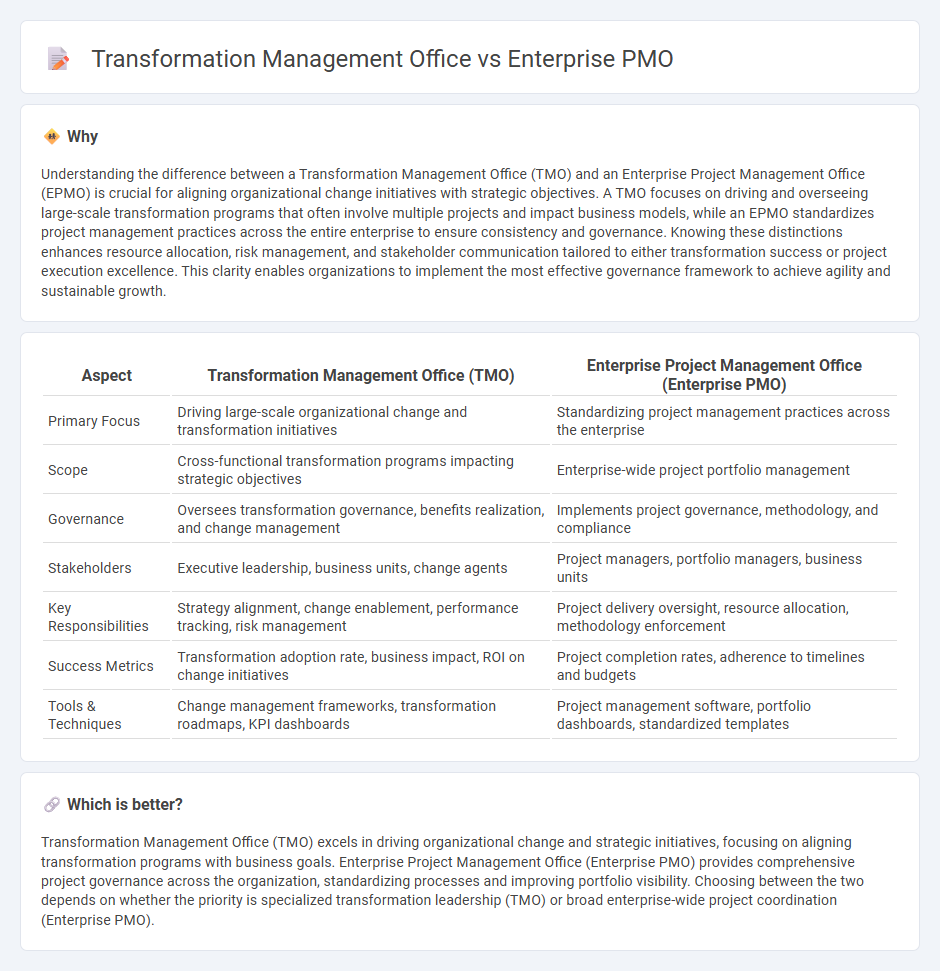
Transformation Management Office (TMO) focuses on driving strategic change initiatives and aligning transformation efforts with business objectives, ensuring agility and innovation throughout the process. Enterprise Project Management Office (EPMO) standardizes project governance, methodologies, and resource management across the organization, fostering consistency and efficiency in project delivery. Explore how TMO and EPMO roles differ and complement each other to optimize organizational change and project success.
Why it is important
Understanding the difference between a Transformation Management Office (TMO) and an Enterprise Project Management Office (EPMO) is crucial for aligning organizational change initiatives with strategic objectives. A TMO focuses on driving and overseeing large-scale transformation programs that often involve multiple projects and impact business models, while an EPMO standardizes project management practices across the entire enterprise to ensure consistency and governance. Knowing these distinctions enhances resource allocation, risk management, and stakeholder communication tailored to either transformation success or project execution excellence. This clarity enables organizations to implement the most effective governance framework to achieve agility and sustainable growth.
Comparison Table
| Aspect | Transformation Management Office (TMO) | Enterprise Project Management Office (Enterprise PMO) |
|---|---|---|
| Primary Focus | Driving large-scale organizational change and transformation initiatives | Standardizing project management practices across the enterprise |
| Scope | Cross-functional transformation programs impacting strategic objectives | Enterprise-wide project portfolio management |
| Governance | Oversees transformation governance, benefits realization, and change management | Implements project governance, methodology, and compliance |
| Stakeholders | Executive leadership, business units, change agents | Project managers, portfolio managers, business units |
| Key Responsibilities | Strategy alignment, change enablement, performance tracking, risk management | Project delivery oversight, resource allocation, methodology enforcement |
| Success Metrics | Transformation adoption rate, business impact, ROI on change initiatives | Project completion rates, adherence to timelines and budgets |
| Tools & Techniques | Change management frameworks, transformation roadmaps, KPI dashboards | Project management software, portfolio dashboards, standardized templates |
Which is better?
Transformation Management Office (TMO) excels in driving organizational change and strategic initiatives, focusing on aligning transformation programs with business goals. Enterprise Project Management Office (Enterprise PMO) provides comprehensive project governance across the organization, standardizing processes and improving portfolio visibility. Choosing between the two depends on whether the priority is specialized transformation leadership (TMO) or broad enterprise-wide project coordination (Enterprise PMO).
Connection
Transformation Management Office (TMO) and Enterprise Project Management Office (EPMO) collaborate closely to ensure strategic alignment and effective governance of organizational change initiatives. TMO drives transformational projects by focusing on change management, benefits realization, and stakeholder engagement, while EPMO oversees enterprise-wide project portfolio management, resource allocation, and standardization of project methodologies. Their integration optimizes project delivery, enhances decision-making transparency, and accelerates achievement of business objectives.
Key Terms
Governance structure
The Enterprise PMO (Project Management Office) primarily establishes standardized governance structures to ensure consistent project delivery across the organization, emphasizing resource allocation, risk management, and compliance. In contrast, the Transformation Management Office drives governance with a focus on strategic change initiatives, aligning transformation goals with business strategy and stakeholder engagement to manage complex, cross-functional changes. Explore detailed governance models and best practices to optimize your organization's project and transformation management frameworks.
Strategic alignment
The Enterprise PMO (Project Management Office) typically ensures strategic alignment by standardizing project execution and governance across the organization, directly supporting long-term business objectives. In contrast, the Transformation Management Office (TMO) is specifically focused on managing change initiatives that drive organizational transformation, emphasizing agility and innovation to achieve strategic shifts. Discover how leveraging both PMO and TMO can optimize your company's path to strategic success.
Change management
An Enterprise PMO (Project Management Office) primarily oversees the alignment of projects with organizational strategy, ensuring consistent governance and resource allocation across departments. In contrast, a Transformation Management Office (TMO) concentrates on driving change management initiatives, facilitating business transformation through stakeholder engagement, communication, and sustained adoption of new processes. Explore how integrating both frameworks enhances organizational agility and successful change implementation.
Source and External Links
EPMO Framework: Definition, Structure, Roles and Responsibilities - An Enterprise PMO (EPMO) is a centralized governance body connecting organizational objectives to project work, aligning all projects with enterprise strategy to improve project success rates and risk management across an organization.
What Is Enterprise Project Management Office? (EPMO) - The EPMO is an executive-level department that oversees project portfolios enterprise-wide by defining strategic objectives, developing governance, and ensuring project alignment and efficiency through change management.
EPMO vs. PMO: Best Project Management Approach - OnePlan - Operating at the executive level, an EPMO provides direct engagement with leadership to prioritize projects based on strategic goals, supporting decision-making, process improvement, and ensuring all initiatives align with the organization's long-term success.
 dowidth.com
dowidth.com